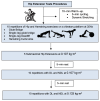Effects of Different Moments of Inertia on Neuromuscular Performance in Elite Female Soccer Players During Hip Extension Exercise to Prevent Hamstring Asymmetries and Injuries: A Cross-Sectional Study
- PMID: 40711097
- PMCID: PMC12297925
- DOI: 10.3390/sports13070212
Effects of Different Moments of Inertia on Neuromuscular Performance in Elite Female Soccer Players During Hip Extension Exercise to Prevent Hamstring Asymmetries and Injuries: A Cross-Sectional Study
Abstract
Background: High-intensity actions like accelerations and decelerations, often performed unilaterally, are crucial in elite female football but increase the risk of interlimb asymmetries and injury. Flywheel resistance training enhances eccentric strength, yet limited research has assessed how different inertial loads affect mechanical outputs in unilateral exercises.
Purpose: This study investigated how two inertial loads (0.107 kg·m2 and 0.133 kg·m2) influence power, acceleration, speed, and asymmetry during unilateral hip extensions in elite female footballers.
Methods: Eighteen professional players (27 ± 4 years, 59.9 ± 6.5 kg, 168.2 ± 6.3 cm, BMI 21.2 ± 1.8) completed unilateral hip extensions on a conical flywheel under both inertia conditions. A rotary encoder measured peak/average power, acceleration, speed, and eccentric-to-concentric (E:C) ratios. Bilateral asymmetries between dominant (DL) and non-dominant (NDL) limbs were assessed. Paired t-tests and Cohen's d were used for analysis.
Results: Higher inertia reduced peak and mean acceleration and speed (p < 0.001, d > 0.8). Eccentric peak power significantly increased in the NDL (p < 0.001, d = 3.952). E:C ratios remained stable.
Conclusions: Greater inertial loads reduce movement velocity but increase eccentric output in the NDL, offering potential strategies to manage neuromuscular asymmetries in elite female football players.
Keywords: acceleration output; cone-shaped prevention exercise; hamstrings asymmetry; inertia load; iso-inertial devices; power output; speed output.
Conflict of interest statement
The authors declare no conflicts of interest.
Figures







Similar articles
-
Discriminative validity of summarized hip and knee angular accelerations for lower extremity training load quantification in male soccer players during a standardised training drill.Sci Med Footb. 2025 Feb;9(1):59-67. doi: 10.1080/24733938.2023.2290083. Epub 2023 Dec 7. Sci Med Footb. 2025. PMID: 38059842 Free PMC article.
-
Power Indices Through Rotational Inertial Devices for Lower Extremity Profiling and Injury Risk Stratification in Professional Soccer Players: A Cross-Sectional Study.Diagnostics (Basel). 2025 Jul 2;15(13):1691. doi: 10.3390/diagnostics15131691. Diagnostics (Basel). 2025. PMID: 40647690 Free PMC article.
-
Application of Global Positioning System and Microsensor Technology in Competitive Rugby League Match-Play: A Systematic Review and Meta-analysis.Sports Med. 2016 Apr;46(4):559-88. doi: 10.1007/s40279-015-0440-6. Sports Med. 2016. PMID: 26714810
-
How Different Velocity-Loss Thresholds Impact Acute Neuromuscular Fatigue in Flywheel Resistance Training.Int J Sports Physiol Perform. 2025 May 30;20(7):993-1001. doi: 10.1123/ijspp.2024-0504. Print 2025 Jul 1. Int J Sports Physiol Perform. 2025. PMID: 40447271 Clinical Trial.
-
The development, retention and decay rates of strength and power in elite rugby union, rugby league and American football: a systematic review.Sports Med. 2013 May;43(5):367-84. doi: 10.1007/s40279-013-0031-3. Sports Med. 2013. PMID: 23529287
References
-
- Moreno-Azze A., Arjol-Serrano J.L., Falcón-Miguel D., Bishop C., Gonzalo-Skok O. Effects of Three Different Combined Training Interventions on Jump, Change of Direction, Power Performance, and Inter-Limb Asymmetry in Male Youth Soccer Players. Sports. 2021;9:158. doi: 10.3390/sports9120158. - DOI - PMC - PubMed
LinkOut - more resources
Full Text Sources

